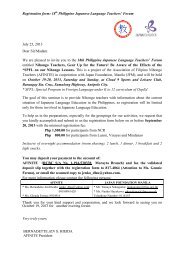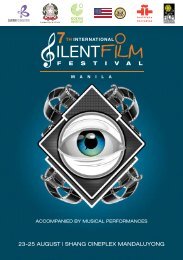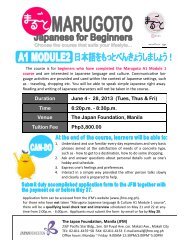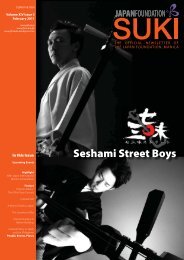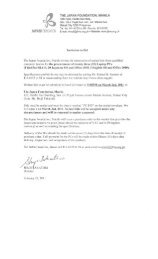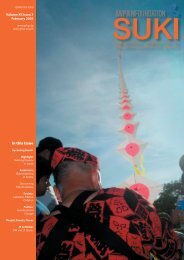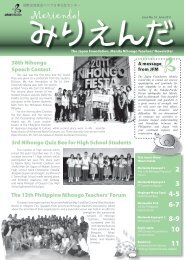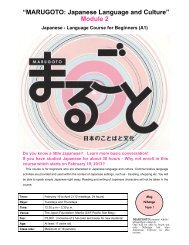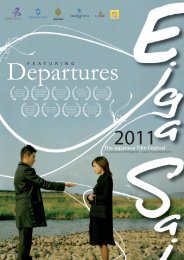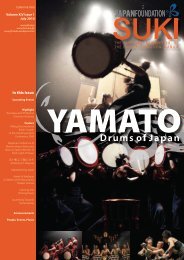Merienda! - The Japan Foundation, Manila
Merienda! - The Japan Foundation, Manila
Merienda! - The Japan Foundation, Manila
Create successful ePaper yourself
Turn your PDF publications into a flip-book with our unique Google optimized e-Paper software.
<strong>The</strong> JF <strong>Manila</strong> Lecture Series Photo DiarySapin-sapin. A rice cake in layers of different colors. One of a variety of kakaninSapin-sapinJFM Monthly L Le cture e Series月 例 日 本 語 教 育 研 究 交 流<strong>The</strong> monthly Lecture Series is an interactive endeavor (learning/ sharing) among Filipino, <strong>Japan</strong>ese and other overseasbasedlanguage teachers and specialists. It is a continuous effort for professional enrichment, and in general, for thefurther encouragement of <strong>Japan</strong>ese-language education and <strong>Japan</strong>ese studies in the Philippines. All presentations ofthe Lecture Series are held at the JF <strong>Manila</strong> office and are usually scheduled every last Friday of the month.Please take note of announcements of schedule changes.32nd SessionFriday, 8 February 2008Acquisition of Conditional Expressions among FilipinoStudents of <strong>Japan</strong>ese LanguageDr. Mary Ann Gaitan-BacolodAssistant professor, Dept. of LinguisticsCSSP, University of the Philippines, DilimanIt is said that <strong>Japan</strong>ese conditional expressions, such as “TARA”, “BA” are some of the mostdifficult to be acquired by foreign students since their usage and meaning are very similar. Dr.Bacolod presented her research about the problems encountered as well as the strategies usedby Filipino students in their acquisition of “TARA” and “BA” conditional expressions.Thursday, 6 March 2008<strong>Japan</strong>ese Culture and Society which is not writtenin textbooks19 students from Osaka University33rd Session<strong>The</strong> topic was tackled by 19 students from Osaka University majoring in <strong>Japan</strong>eseStudies. <strong>The</strong>y talked about the life of university students in <strong>Japan</strong>, information which isnot found in textbooks nor on the internet. This was a good opportunity to get to knowthe current lifestyle of the <strong>Japan</strong>ese youth.34th Session Friday, 4 April 2008<strong>The</strong> History of <strong>Japan</strong>ese Language Education At AWSMs. Ayako Minami<strong>Japan</strong>ese Language Advisor, Advanced World SolutionsThis being her last lecture before going back to <strong>Japan</strong>, Ms. Ayako Minami introducedvarious aspects of the AWS’ <strong>Japan</strong>ese Language Education Program such as the curriculum,unique activities (presentation contest, etc.), teaching of Business Nihongo,conducting JLPT reviews, the multifaceted role of the coordinator, etc.Friday, 27 June 2008<strong>Japan</strong>ese as a Heritage Language — A Case Studyof <strong>The</strong> <strong>Japan</strong>ese-Filipino Children in the PhilippinesMs. Alice Mary Itchon<strong>Japan</strong>ese Language Teacher, Nihongo Center <strong>Foundation</strong><strong>The</strong> increase in the number of <strong>Japan</strong>ese-Filipino marriages brings about the need fortheir children staying in the Philippines to study the <strong>Japan</strong>ese language. However, languageschools are not prepared for this type of learners - hence, the absence of a curriculum.Ms. Itchon reported on the current needs of these young learners – reasons/goals for studying the language, attitude towards <strong>Japan</strong>ese language schools, ethnicidentity, and parental involvement.35th Session<strong>The</strong> <strong>Japan</strong> <strong>Foundation</strong> <strong>Manila</strong> Nihongo Teachers’ Newsletter7



